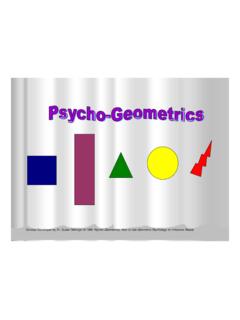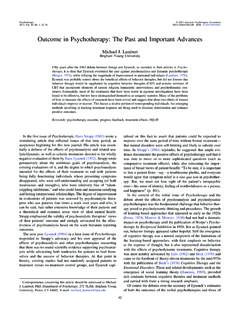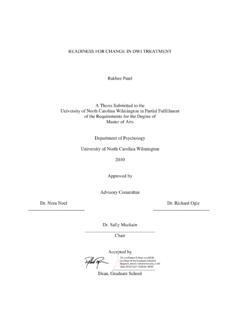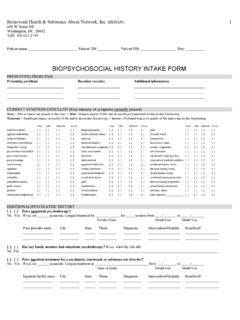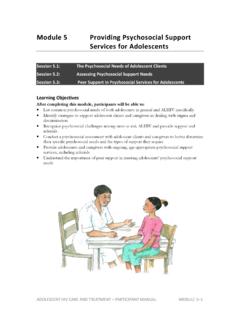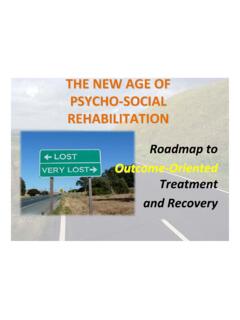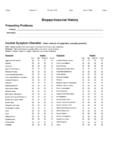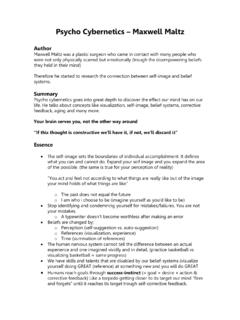Transcription of The Biopsychosocial Approach to Chronic Pain: Scientific ...
1 The Biopsychosocial Approach to Chronic Pain: Scientific Advances andFuture DirectionsRobert J. Gatchel and Yuan Bo PengThe University of Texas at ArlingtonMadelon L. PetersMaastricht UniversityPerry N. FuchsThe University of Texas at ArlingtonDennis C. TurkUniversity of Washington, SeattleThe prevalence and cost of Chronic pain is a major physical and mental health care problem in the UnitedStates today. As a result, there has been a recent explosion of research on Chronic pain, with significantadvances in better understanding its etiology, assessment, and treatment. The purpose of the presentarticle is to provide a review of the most noteworthy developments in the field.
2 The biopsychosocialmodel is now widely accepted as the most heuristic Approach to Chronic pain. With this model in mind,a review of the basic neuroscience processes of pain (thebiopart of Biopsychosocial ), as well as thepsychosocial factors, is presented. This spans research on how psychological and social factors caninteract with brain processes to influence health and illness as well as on the development of newtechnologies, such as brain imaging, that provide new insights into brain-pain : Biopsychosocial , Chronic pain, neuroscience of pain, pain and cognition, pain and emotionDuring the past decade, there has been an explosion of researchon Chronic pain, with significant advances in understanding itsetiology, assessment, and treatment (Gatchel, 2004a, 2004b, 2005;Turk & Monarch, 2002).
3 This research has important health careimplications. Epidemiological research has shown that chronicpain (loosely defined as prolonged and persistant pain of at least 3months in duration) and Chronic recurrent pain (recurrent episodesof pain interspersed with pain-free periods extending over monthsor years) affects 10% 20% of adults in the general population(Blyth et al., 2001; Gureje, Von Korff, Simon, & Gater, 1998;Verhaak, Kerssens, Dekker, Sorbi, & Bensing, 1998). For exam-ple, in a large-scale epidemiological study, Von Korff et al. (2005)estimated a 19% prevalence for Chronic spinal pain (neck andback) in the United States in the previous year and a 29% lifetimerate.
4 The American Academy of Pain Management (2003) assertedthat approximately 57% of all adult Americans reported experi-encing recurrent or Chronic pain in the past year. About 62% ofthose individuals reported being in pain for more than 1 year, and40% noted that they were constantly in pain. Indeed, as Gatchel(2004a, 2004b) has summarized, pain is a pervasive medicalproblem: It affects over 50 million Americans and costs more than$70 billion annually in health care costs and lost productivity; itaccounts for more than 80% of all physician visits. Moreover, Chronic pain is often associated with major comorbid psychiatricdisorders and emotional the above factors attest, the prevalence and cost of chronicpain is a major physical and mental health care problem in theUnited States.
5 Moreover, individuals 50 years of age and older aretwice as likely to have been diagnosed with Chronic pain (Gatchel,2004, 2005). Currently, there are approximately 35 million Amer-icans aged 65 years or older, accounting for of the totalpopulation. The proportion of the population aged 65 and over isexpected to increase by 57% by the year 2030, with Americansnow having an average life expectancy of 77 years (Social SecurityAdministration, ). Awareness of these population trends hascontributed to an increased concern about health care issues ofolder Americans, including Chronic pain problems.
6 With theseestimates in mind, it is not surprising that the Congressdesignated 2001 2010 as the Decade of Pain Control and Researchand that the Joint Commission on Accreditation of HealthcareOrganizations now requires physicians to consider pain as the fifthvital sign (added to the other vital signs of pulse, blood pressure,core temperature, and respiration).The statistics cited above and population trends have fueleda great deal of research on Chronic pain. The purpose of thepresent article is to provide a review of some of the mostnoteworthy Scientific advances in this area. As is initiallydiscussed, the Biopsychosocial model has proved to be the mostwidely accepted and most heuristic perspective to the under-standing and treatment of Chronic pain.
7 Subsequently, reviewsRobert J. Gatchel and Yuan Bo Peng, Department of Psychology, TheUniversity of Texas at Arlington; Madelon L. Peters, Department ofMedical, Clinical and Experimental Psychology, Maastricht University,The Netherlands; Perry N. Fuchs, Department of Psychology and Depart-ment of Biology, The University of Texas at Arlington; Dennis C. Turk,Department of Anesthesiology, University of Washington, of this article was supported by National Institutes of HealthGrants 1K05-MH071892, 2R01 DE 010713, and 2R01 MH 046452; De-partment of Defense Grant DAMD17-03-1-0055; and National Institute ofArthritis and Musculoskeletal and Skin Diseases Grants AR44724 concerning this article should be addressed to Robert , Department of Psychology, University of Texas at Arlington, Box19528, Arlington, TX 76063.
8 E-mail: BulletinCopyright 2007 by the American Psychological Association2007, Vol. 133, No. 4, 581 6240033-2909/07/$ DOI: important biobehavioral mechanisms and psychosocial fac-tors are Biopsychosocial model of Chronic PainThe traditional Approach embraced a dualistic viewpoint thatconceptualized the mind and body as functioning separately andindependently. The inadequacy of the dualistic model contributedto a growing recognition that psychosocial factors, such as emo-tional stress, could impact the reporting of symptoms, medicaldisorders, and response to treatment. George Engel (1977) iscredited as one of the first to call for the need of a new approachto the traditional biomedical reductionistic philosophy that domi-nated the field of medicine since the Renaissance.
9 This subse-quently led to the growth of the field of behavioral medicine andhealth psychology (Gatchel & Baum, 1983). A major outgrowth, inturn, was the development and evolution of the biopsychosocialmodel. This model has been especially influential in the area ofchronic Biopsychosocial model focuses on both disease and illness,with illness being viewed as the complex interaction of biological,psychological, and social factors (Gatchel, 2005). As succinctlysummarized by several authors ( , Gatchel, 2004a, 2004b; Turk& Monarch, 2002),diseaseis defined as an objective biologicalevent involving the disruption of specific body structures or organsystems caused by either anatomical, pathological, or physiologi-cal changes.
10 In contrast,illnessrefers to a subjective experience orself-attribution that a disease is present. Thus, illness refers to howa sick person and members of his or her family live with, andrespond to, symptoms of distinction between disease and illness is analogous to thedistinction that can be made involves the stimulation of nerves that convey informationabout potential tissue damage to the brain. In contrast, pain is thesubjective perception that results from the transduction, transmis-sion, and modulation of sensory information. This input may befiltered through an individual s genetic composition, prior learninghistory, current psychological status, and sociocultural pain to be registered, the organism must be conscious.
